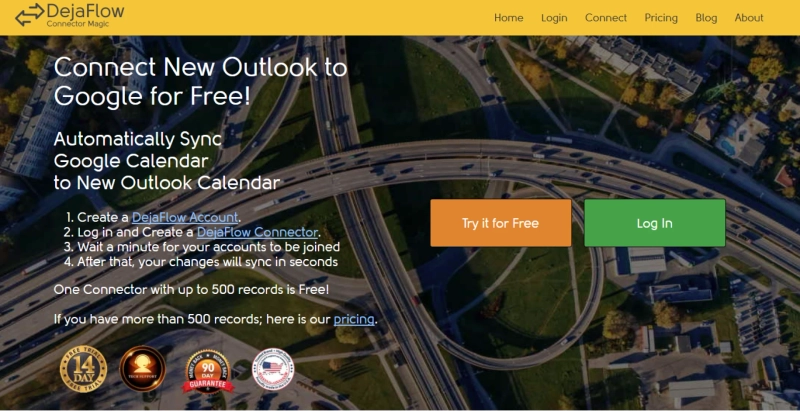Calendar reliability shapes every workday. When edits in Outlook do not appear in Google, or when the same meeting shows up twice, coordination slows and people miss important cues. DejaFlow provides a focused, cloud-based connector that keeps Microsoft and Google in step without requiring a desktop agent. The goal of this guide is simple and practical: achieve Two-Way Sync New Outlook and Google Calendar Without Duplicates using a clear workflow that you can repeat for teammates.
If you are starting from scratch, DejaFlow makes it straightforward to sync a new Outlook calendar with Google Two-Way while keeping control over which calendars are paired and how the first pass runs. If you have tried other utilities, this plan shows how to remove conflict sources, establish one clean mapping, and avoid looped inserts that create doubles.
Why duplicates happen in calendar sync:
Before tuning DejaFlow, it helps to understand the root causes of duplication so you can avoid duplicate events, such as Google Outlook sync problems, in the future.
- Two or more tools push the same event in both directions.
- Initial imports overlap widely, so each side treats past items as new.
- Recurring series expand differently across platforms, so one service rebuilds copies.
- Time zone or organizer changes cause a system to create a fresh event instead of updating the original.
- People accept invitations in one calendar and then manually add copies in another.
DejaFlow reduces these risks by running as the single authority for your pair of calendars and by letting you scope the first sync smartly.
What DejaFlow does and why it helps
DejaFlow runs in the cloud. After you authorize Outlook and Google, it keeps watching for changes and applies them in short intervals. Because one connector manages both directions, the risk of collisions drops. The interface encourages a measured first pass so you do not flood the pipeline with years of historical events.
If you are cleaning up an existing mess, DejaFlow also helps you fix Google Outlook calendar duplicates by letting one system act as the truth while the connector reconciles the partner side. That sequence turns uncontrolled duplicates into a stable one-to-one mapping.
The core workflow: Two-way sync without duplicates
Step 1: Prepare your data:
- Identify the account that currently holds the most accurate events.
- Remove every other sync tool or automation that touches these calendars.
- Delete obvious doubles from your chosen source account.
- Decide exactly which Google calendar will pair with which Outlook calendar.
This preparation makes it feasible to sync Outlook 365 to Google Calendar without duplicates because the connector will not compete with other processes.
Step 2: Create your DejaFlow Connector
Add a connector, authorize both accounts, and choose two-way for calendars. Select the specific Outlook and Google calendars to pair. Starting with a single pair ensures the mapping is clear and resilient. If you ever need a second pair, create a second connector rather than mixing multiple pairs into one.
For new users, this setup effectively serves as a dejaflow calendar connector setup guide inside the product, since each step is visible and reversible.
Step 3: Use a smart first-sync window
Begin with upcoming events and a modest amount of recent history. Large historical ranges invite overlap. A smaller window lets DejaFlow build precise relationships between corresponding items. Avoid editing calendar entries on both platforms during the very first cycle so the connector can complete the initial map.
Step 4: Verify the mapping
Open the same week in both New Outlook and Google. Edit a test event title on Outlook and confirm the change appears in Google. Edit the time or location on Google and check that Outlook receives the update. If both directions work, you have a clean two-way link.
Step 5: Operate normally
Once verified, work wherever it is convenient. Create, move, and cancel from either side. DejaFlow will update the corresponding item rather than create a new copy. This is the practical heart of two-way calendar sync, Outlook.com and Google, with data integrity in mind.
Handling invitations and RSVPs
Invitations can be a source of accidental duplication if you accept in both places. Choose one primary calendar for RSVPs and let DejaFlow propagate status to the partner. When you follow this habit, Outlook and Gmail calendar sync without duplicate invites becomes an everyday reality.
Recurring meetings and time zones
Recurring series sometimes behave differently between Outlook and Google. Use these habits to prevent recurring event duplicates in Outlook and Google without extra effort.
- Edit the recurrence rule on the original organizer account whenever possible.
- Confirm both services are set to the correct time zone before creating a series.
- If a single instance is stubborn, remove only that instance on the secondary side and recreate it from the primary side.
These simple steps keep the series aligned so updates apply to the same object, not to a second copy.
Color categories and visual clarity
Visual cues speed comprehension. If you prefer coding meetings by theme or team, try to map categories to Google Calendar colors in a consistent way. While category systems are not identical between platforms, keeping a documented mapping table for the shared pair ensures that color intent remains recognizable on both sides.
Free tier considerations and scope control
Many individual users can succeed on the free plan by focusing on calendars and keeping total records modest. If that matches your use case, then the new Outlook Google Calendar two-way free tier effectively describes the strategy: pair one Outlook calendar to one Google calendar, keep archives out of scope for the initial pass, and proceed once you confirm everything looks right.
Maintenance habits that keep the map clean
- Keep DejaFlow as the only integration that writes to these calendars.
- Resist multi-tool stacks that claim to add special cases for meetings.
- Add a quick note in your team handbook that explains how the pairing works.
- If you must perform a large cleanup, pause edits for a short window, adjust one side only, and let the connector reconcile.
These habits keep the one-to-one mapping intact month after month.
Troubleshooting quick answers
1. A new meeting appeared twice after the first run:
Confirm that no other sync app is active. Remove the extra copy from only one side, then allow a full DejaFlow cycle to reconcile. Do not delete both copies.
2. Updates flow from Google to Outlook, but not the other way:
Verify that the connector direction is two-way, not one-way. Make a tiny title change in Outlook and wait for it to appear in Google as a test.
3. A recurring series is duplicated, but single events are fine:
Standardize the recurrence rule on your primary account. Remove the duplicate series on the secondary side, then recreate from the primary side.
4. I need a full reset:
Disable other integrations, decide which account is the truth, remove duplicates from the secondary account, then rebuild the connector with a narrow initial window.
Advanced patterns with teams
When teams share several calendars, establish a clear pairing policy. For editorial teams, keep the publishing calendar as the only paired asset and keep personal or read-only calendars outside the connector. For operations teams with shift schedules, create separate pairs for each department rather than one large tangle. These patterns reduce interaction surfaces and maintain clarity.
If you manage both Outlook.com and Microsoft 365 tenants, apply separate connectors and never point two connectors at the same two calendars. That small rule prevents looped updates and makes each pair easy to audit.
Security, privacy, and reliability notes
DejaFlow relies on modern authorizations and does not require a desktop agent to run, which limits the number of moving parts in your environment. Since it operates in the cloud, calendars continue to stay in sync even when your PC is offline. Treat your accounts with the same care you would give to email, and rotate passwords or sign-ins as part of regular hygiene.
Conclusion
A dependable schedule is a strategic asset. With one connector, a scoped setup, and consistent habits, DejaFlow delivers Two-Way Sync New Outlook and Google Calendar Without Duplicates that lasts. Prepare your calendars, remove competing tools, run a careful first sync, and verify both directions with small test edits.
Use one calendar for RSVPs, maintain a simple color mapping, and avoid multi-tool stacks that fight each other. When you follow this plan, your meetings line up everywhere you look, and coordination becomes faster and calmer.


